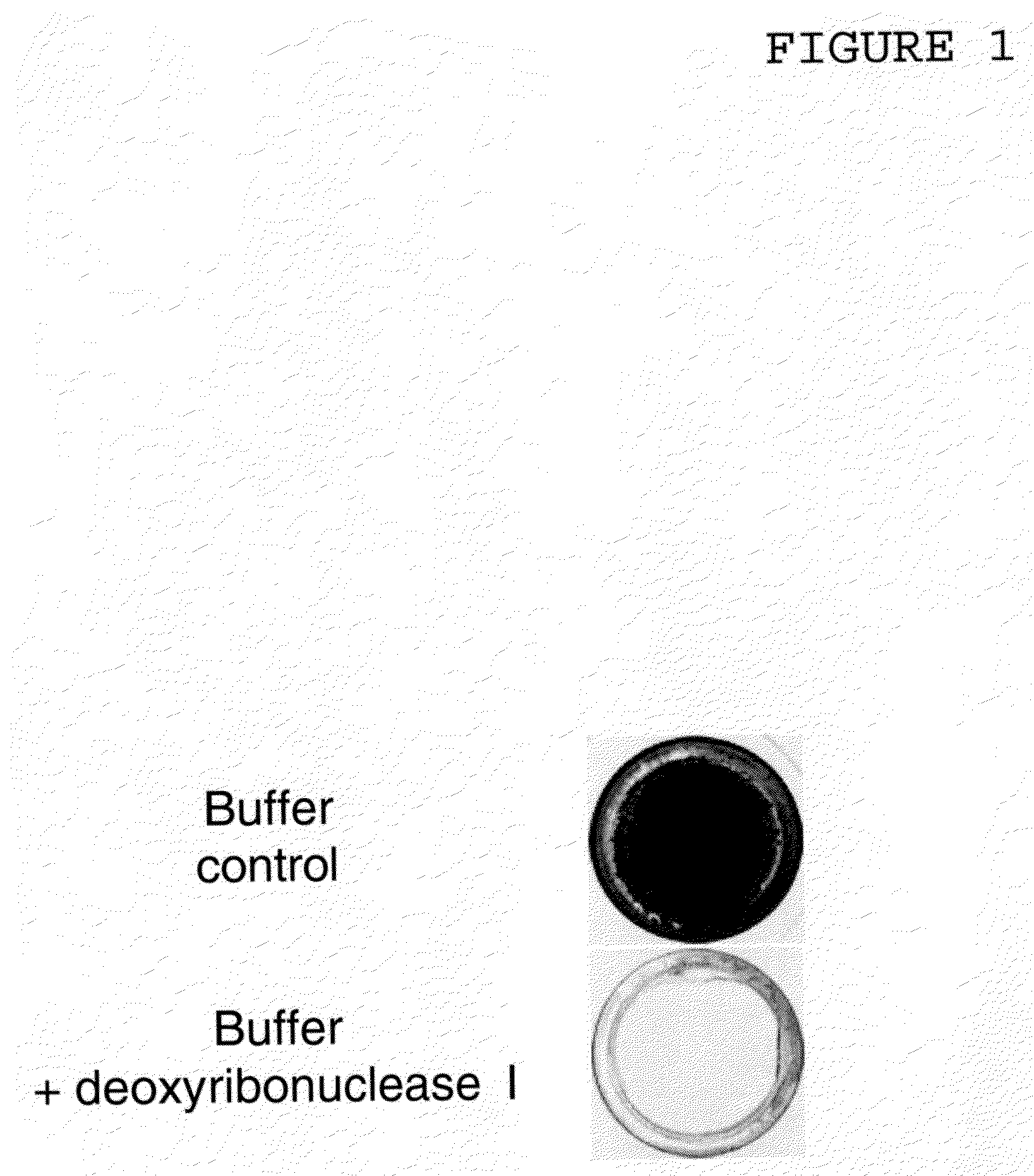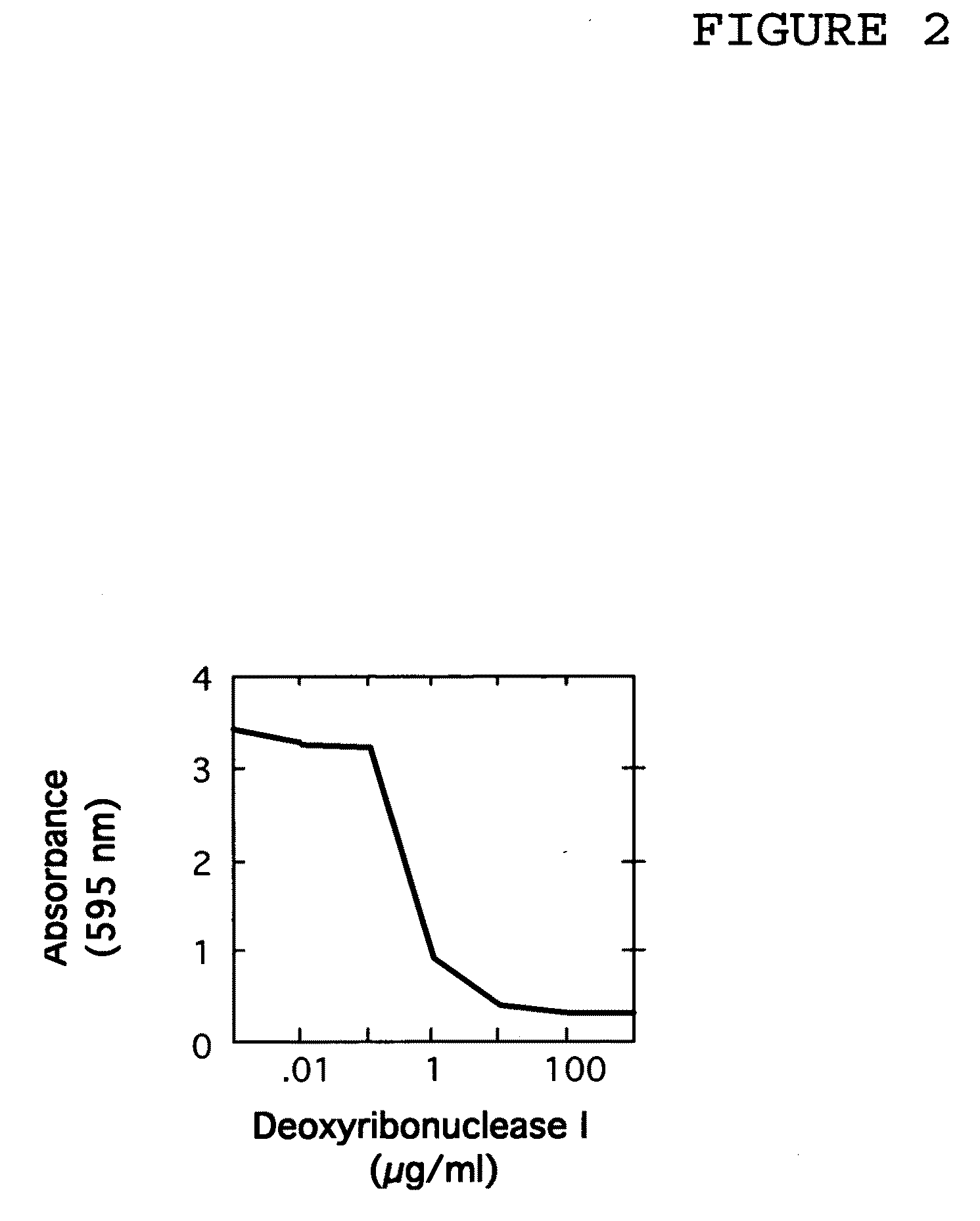Compositions and methods for the treatment and prevention of infections caused by staphylococcus aureus bacteria
a technology of staphylococcus aureus and compositions, applied in the direction of antibacterial agents, biocides, peptide/protein ingredients, etc., can solve the problem that biofilms that form on tissues or medical devices are extremely difficult to eradicate, and achieve the effect of preventing and/or inhibiting the growth of biofilms
- Summary
- Abstract
- Description
- Claims
- Application Information
AI Technical Summary
Benefits of technology
Problems solved by technology
Method used
Image
Examples
example 1
Deoxyribonuclease I Causes the Detachment and Dispersal of S. aureus Biofilms
[0046]S. aureus Strain SH1000 (Horsburgh et al., 2002. J. Bacteriol. 184:5457-5467) was used in all of the following examples. The bacteria were passaged weekly on blood agar and stored at 4° C. Biofilms were cultured in Tryptic Soy broth (Becton-Dickinson, Sparks, Md.) containing 6 g of yeast extract and 8 g of glucose per liter (TSB medium). All cultures were incubated at 37° C.
[0047]A biofilm formation assay was carried out as follows. A loopful of cells from an agar plate was transferred to a polypropylene microcentrifuge tube containing 200 μl of TSB medium. The cells were crushed with a disposable pellet pestle, vortexed for 30 sec, diluted to 1 ml in fresh TSB medium, and then passed through a 5-μm pore-size syringe filter to remove large clumps of cells as previously described (Kaplan & Fine, 2002. Appl. Environ. Microbiol. 68:4943-4950). Filtered cells were diluted to 103-105 CFU / ml in TSB medium. ...
example 2
Deoxyribonuclease I Inhibits S. aureus Autoaggregation and Biofilm Formation
[0051]A series of experiments was performed in order to demonstrate that deoxyribonuclease I inhibits S. aureus autoaggregation and biofilm formation. These experiments were carried out as described above, except that biofilms were grown in 16-mm×100-mm PET tubes (2 ml culture vol) in a rotary shaker for 16 h. FIG. 4 shows S. aureus SH1000 cells cultured in this manner in unsupplemented TSB medium formed large aggregates, whereas cells cultured in this manner in TSB medium supplemented with 100 μg / ml of deoxyribonuclease I formed smaller aggregates. Crystal violet staining of the culture tubes showed that deoxyribonuclease I inhibited biofilm formation at the air-liquid interface (FIG. 5).
[0052]FIG. 6 shows that SH1000 biofilms grown for 24 h in 96-well microtiter plates in unsupplemented TSB medium formed distinct, spherical colonies that were tightly attached to the microwell surface, whereas biofilms grow...
example 3
Deoxyribonuclease I Increases the Sensitivity of S. aureus Biofilm Cells to Killing by the Quaternary Ammonium Compound Cetylpyridinium Chloride (CPC)
[0053]Biofilms were grown for 24 h in 96-well microtiter plates as described above. Biofilms were rinsed once with water and then treated with 200 μl of TSB medium containing 100 μg / ml of deoxyribonuclease I. Control wells were treated with 200 μl of TSB medium alone. After 10 min at 37° C., 20 μl of 3% CPC was added to each well and biofilms were incubated for 5 min at room temperature. Control wells received 20 μl of water. For biofilms treated with TSB medium alone, biofilms were washed four times with phosphate buffered saline to remove the CPC, and then treated with 100 μg / ml of deoxyribonuclease I to dissolve the biofilm. This reactions was carried out in 100 μg / ml in 150 mM NaCl, 1 mM CaCl2 as described above. After 10 min, cells were mixed and then serial dilutions were plated on agar. For S. aureus biofilms treated with deoxyr...
PUM
| Property | Measurement | Unit |
|---|---|---|
| concentration | aaaaa | aaaaa |
| temperature | aaaaa | aaaaa |
| resistance | aaaaa | aaaaa |
Abstract
Description
Claims
Application Information
 Login to View More
Login to View More - R&D
- Intellectual Property
- Life Sciences
- Materials
- Tech Scout
- Unparalleled Data Quality
- Higher Quality Content
- 60% Fewer Hallucinations
Browse by: Latest US Patents, China's latest patents, Technical Efficacy Thesaurus, Application Domain, Technology Topic, Popular Technical Reports.
© 2025 PatSnap. All rights reserved.Legal|Privacy policy|Modern Slavery Act Transparency Statement|Sitemap|About US| Contact US: help@patsnap.com



